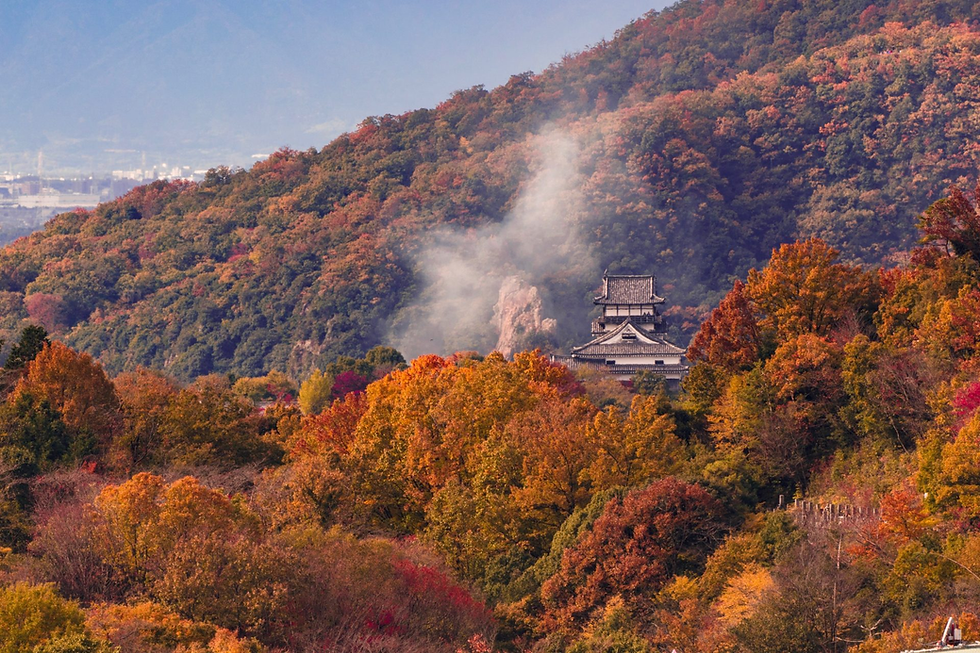A Journey Through Time in Aichi Prefecture | MK Travel
- M.R. Lucas
- Oct 28
- 4 min read
Updated: 5 days ago

Between the mountains and plains of central Japan, Aichi Prefecture spans centuries. Once a crossroads of samurai ambition and industrial innovation, it is where Japan’s modern spirit first took shape. Here, the sixteenth-century Inuyama Castle still guards the Kiso River, while nearby Meiji-mura preserves the Western-inspired architecture of Japan’s first modern era.
MK’s driver-guided private tours provide the most seamless way to explore these layered histories. From Nagoya or Chubu Centrair Airport, your route heads north through rolling farmland to castle walls, preserved town streets, and open-air museums where the Meiji era still stands in brick and glass.
This isn’t just sightseeing. It’s time travel — enhanced by comfort, accuracy, and hospitality.
The MK Experience

MK isn’t just a taxi — it’s a philosophy on wheels. A chartered journey where luxury, hospitality, and local knowledge come together to create something unforgettable. MK’s drivers aren’t just chauffeurs; they’re road guides, trained in etiquette, regional culture, and tourism insight. Over 300 hours of training ensure that each trip proceeds with precision and grace.
Doors open before you reach for them. Luggage is handled with white-gloved care. Conversation flows — or doesn’t — at your pace. MK’s multilingual service in English and Chinese removes language barriers, leaving only calm and clarity.
The fleet — BMW, Benz, Lexus — balances silence and smoothness, turning every ride into a moving sanctuary. Whether cruising through neon-lit cityscapes or winding across Aichi’s countryside, MK elevates travel into a carefully curated experience.
Inuyama Castle — A Timeless Fortress Over the Kiso River

On the distinguished banks of the Kiso River, Inuyama Castle stands among Japan’s most treasured sites — one of only twelve original castles still standing and one of five National Treasures.
Built in 1537 by Oda Nobuhide, the father of Oda Nobunaga, it became a key part of central Japan’s power struggles. From its watchtower, the fertile Nōbi Plains extend outward — a stage for centuries of ambition. When Nobunaga’s reign ended in the Honnō-ji Incident of 1582, Inuyama persisted, later protected by the Naruse Clan during the Edo period.
After the Great Nōbi Earthquake of 1891, the castle was carefully restored by locals and the Naruse family. For years, it remained Japan’s only privately owned castle before becoming public property in 2004. Today, its wooden stairways, narrow hallways, and panoramic tower stay preserved — a fortress that endured time, not just design.
From the summit, the Kiso River shimmers below — a silver thread connecting centuries together.
Inuyama Castle Town — Where Time Took Shelter

At the base of the keep lies Inuyama Castle Town, a rare remnant of Edo Japan preserved by luck rather than planning. Its machiya townhouses and cobblestone streets escaped destruction from war and modernization alike.
Once home to blacksmiths, fishmongers, and merchants who served the castle, these streets now welcome travelers with teahouses, craft shops, and cafés. The aroma of roasted green tea drifts through cedar lattices; rickshaws, often pulled by comedians-in-training from Nagoya’s Yoshimoto troupe, glide across the stones with playful grace.
Walk slowly. The tiled rooftops and earthen walls create a quiet corridor of memories. Stop for matcha and gohei mochi — rice skewers glazed with miso and walnuts — and enjoy a flavor that has never fallen out of style.
In spring, the Inuyama Festival bursts with energy as thirteen towering floats parade from Haritsuna Shrine, earning UNESCO recognition for its preservation of Edo craftsmanship and local spirit. For that weekend, Inuyama becomes not a museum but a living memory.
Meiji-mura — The Village That Saved Time

A short drive from the castle, Meiji-mura stretches along the banks of Iruka Pond, preserving Japan’s first modern century's architecture.
Its founder, Yoshiro Taniguchi, once mourned the demolition of Tokyo’s Rokumeikan — a Western-style ballroom that represented Japan’s jump into modernity. Determined to preserve the remains of that era, he teamed up with Motoo Tsuchikawa, future president of Nagoya Railroad, and began relocating threatened buildings from all over the country.
Since 1965, Meiji-mura has collected over sixty structures, eleven of which are designated as Important Cultural Properties. Highlights include the reconstructed Imperial Hotel Lobby, designed by Frank Lloyd Wright, and St. Xavier’s Cathedral, relocated from Kyoto, where rose windows still cast stained light over wooden pews.
Here, preservation turns into resurrection — a vibrant conversation between East and West.
The Return

After a day exploring centuries of history, your MK driver waits — engine cooled, itinerary flexible, and timing in your control. Recline, breathe deeply, and watch Aichi roll by your window, along with fields, bridges, and villages where history still lingers.
This isn’t the ride back to Nagoya. It’s your quiet return to now.
The MK Take
From the battlements of a samurai stronghold to the preserved streets of Edo and the Western facades of Meiji modernization, this is Aichi as a time capsule. This region remembers its past by living it. MK transforms that journey through history into something seamless: private, personal, and profoundly peaceful.

Let MK guide you through the roads where Japan remembers itself.
Image Credits
Photos courtesy of Inuyama City Tourism Association(犬山市観光協会)
Photos courtesy of Meiji-mura Official(博物館明治村)


Comments